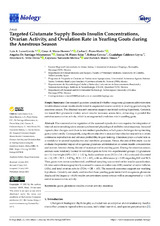Mostrar el registro sencillo del ítem
Targeted glutamate supply boosts insulin concentrations, ovarian activity, and ovulation rate in yearling goats during the anestrous season
| dc.contributor.author | Luna-García, Luis A. | |
| dc.contributor.author | Meza-Herrera, César A. | |
| dc.contributor.author | Pérez-Marín, C.C. | |
| dc.contributor.author | Santiago-Miramontes, Ángeles de | |
| dc.contributor.author | Flores-Salas, Jessica M. | |
| dc.contributor.author | Corona, Rebeca | |
| dc.contributor.author | Calderón Leyva, María Guadalupe | |
| dc.contributor.author | Veliz-Deras, Francisco G. | |
| dc.contributor.author | Navarrete-Molina, Cayetano | |
| dc.contributor.author | Marín-Tinoco, Rubén I | |
| dc.date.accessioned | 2023-10-05T10:17:19Z | |
| dc.date.available | 2023-10-05T10:17:19Z | |
| dc.date.issued | 2023 | |
| dc.identifier.issn | 2079-7737 | |
| dc.identifier.uri | http://hdl.handle.net/10396/26005 | |
| dc.description.abstract | The neuroendocrine regulation of the seasonal reproductive axis requires the integration of internal and external signals to ensure synchronized physiological and behavioral responses. Seasonal reproductive changes contribute to intermittent production, which poses challenges for optimizing goat product yields. Consequently, a significant objective in seasonal reproduction research is to attain continuous reproduction and enhance profitability in goat farming. Glutamate plays a crucial role as a modulator in several reproductive and metabolic processes. Hence, the aim of this study was to evaluate the potential impact of exogenous glutamate administration on serum insulin concentration and ovarian function during the out-of-season period in yearling goats. During the anestrous season, animals were randomly located in individual pens to form two experimental groups: (1) glutamate (n = 10, live weight (LW) = 29.1 ± 1.02 kg, body condition score (BCS) = 3.4 ± 0.2 units) and (2) control (n = 10; LW = 29.2 ± 1.07 kg, BCS = 3.5 ± 0.2), with no differences (p < 0.05) regarding LW and BCS. Then, goats were estrus-synchronized, and blood sampling was carried out for insulin quantification. Ovaries were ultrasonographically scanned to assess ovulation rate (OR), number of antral follicles (AFs), and total ovarian activity (TOA = OR + AF). The research outcomes support our working hypothesis. Certainly, our study confirms that those yearling goats treated with exogenous glutamate displayed the largest (p < 0.05) insulin concentrations across time as well as an augmented (p < 0.05) out-of-season ovarian activity. | es_ES |
| dc.format.mimetype | application/pdf | es_ES |
| dc.language.iso | eng | es_ES |
| dc.publisher | MDPI | es_ES |
| dc.rights | https://creativecommons.org/licenses/by/4.0/ | es_ES |
| dc.source | Biology, 12(7), 1041 (2023) | es_ES |
| dc.subject | Goats | es_ES |
| dc.subject | Glutamate | es_ES |
| dc.subject | Insulin | es_ES |
| dc.subject | Ovarian activity | es_ES |
| dc.subject | Anestrous | es_ES |
| dc.title | Targeted glutamate supply boosts insulin concentrations, ovarian activity, and ovulation rate in yearling goats during the anestrous season | es_ES |
| dc.type | info:eu-repo/semantics/article | es_ES |
| dc.relation.publisherversion | https://doi.org/10.3390/biology12071041 | es_ES |
| dc.rights.accessRights | info:eu-repo/semantics/openAccess | es_ES |

